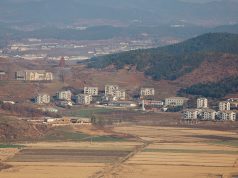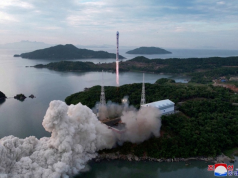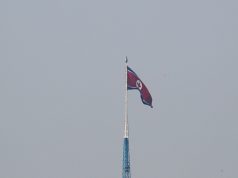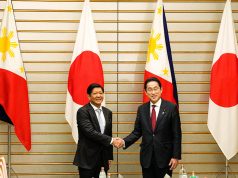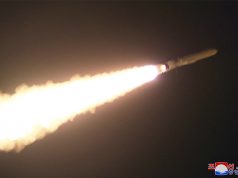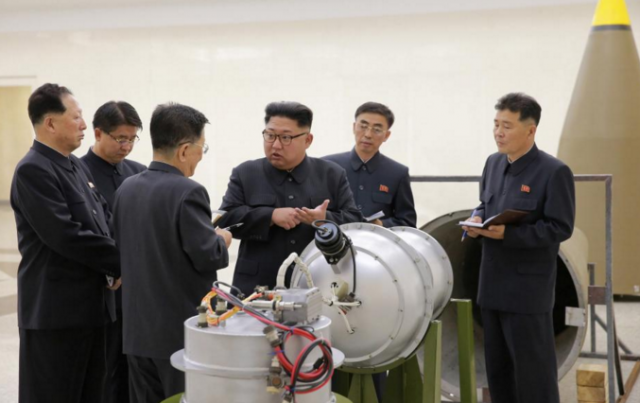
SEOUL – (UPDATED 8:55 P.M.) North Korea conducted its sixth and most powerful nuclear test on Sunday, which it said was an advanced hydrogen bomb for a long-range missile, marking a dramatic escalation of the regime’s stand-off with the United States and its allies.
The announcement from Pyongyang came a few hours after international seismic agencies detected a manmade earthquake near the North’s test site, which Japanese and South Korean officials said was around 10 times more powerful than the tremor picked up after its last nuclear test a year ago.
There was no independent confirmation that the detonation, which drew swift international condemnation, was a hydrogen bomb rather than a less powerful atomic device. But Japan’s Chief Cabinet Secretary Yoshihide Suga said Tokyo could not rule out the possibility that it was a hydrogen bomb.
The test is a direct challenge to US President Donald Trump, who hours earlier had talked by phone with Japanese Prime Minister Shinzo Abe about the “escalating” nuclear crisis in the region and has previously vowed to stop North Korea developing nuclear weapons that could threaten the United States.
North Korea, which carries out its nuclear and missile programs in defiance of United Nations Security Council resolutions and sanctions, said in an announcement on state television that a hydrogen bomb test ordered by leader Kim Jong Un was a “perfect success”.
The bomb was designed to be mounted on its newly developed intercontinental ballistic missile (ICBM), the North said.
UN WATCHDOG: ‘EXTREMELY REGRETTABLE’
The head of the UN’s nuclear watchdog, IAEA Director General Yukiya Amano said the nuclear test was “an extremely regrettable act” that was “in complete disregard of the repeated demands of the international community”.
French President Emmanuel Macron said the international community must react firmly to this “new provocation”, and South Korean President Moon Jae-in said Seoul would push for strong steps to further isolate the North, including new UN sanctions.
Japan also raised the prospect of further sanctions, saying curbs on North Korea’s oil trade would be on the table.
China, North Korea’s sole major ally, said it strongly condemned the nuclear test and urged Pyongyang to stop its “wrong” actions. The United States has repeatedly urged Beijing to do more to rein in its neighbor.
THERMONUCLEAR DEVICE?
North Korea claimed in January last year to have tested a miniaturized hydrogen bomb, also known as a thermonuclear device, but outside experts were skeptical, suggesting it could have been a “boosted device”, an atomic bomb that uses some hydrogen isotopes to increase its explosive yield.
A US official who studies North Korea’s military and politics said it was too early to determine if a test supported the North’s claim that it had succeeded in developing a thermonuclear weapon, “much less one that could be mounted on an ICBM and re-enter Earth’s atmosphere without burning up”.
The latest nuclear test comes amid heightened regional tension following Pyongyang’s two tests of ICBMs in July that potentially could fly about 10,000 km (6,200 miles), putting many parts of the US mainland within range.
Under third-generation leader Kim, North Korea has been pursuing a nuclear device small and light enough to fit on a long-range ballistic missile, without affecting its range and making it capable of surviving re-entry.
One expert said the size of Sunday’s detonation, measured by the US Geological Survey at magnitude 6.3, meant it was possible it could be a hydrogen bomb test.
“The power is 10 or 20 times or even more than previous ones,” said Kune Y. Suh, a nuclear engineering professor at Seoul National University. “That scale is to the level where anyone can say a hydrogen bomb test.”
AIR RAID SIRENS
In the Chinese city of Yanji, on the border with North Korea, witnesses said they felt a tremor that lasted roughly 10 seconds, followed by an aftershock.
“I was eating brunch just over the border here in Yanji when we felt the whole building shake,” Michael Spavor, director of the Paektu Cultural Exchange, which promotes business and cultural ties with North Korea. “It lasted for about five seconds. The city air raid sirens started going off.”
The Comprehensive Test Ban Treaty Organisation (CTBTO) in Vienna said it had detected an “unusual seismic event” in North Korea that was larger than previous nuclear tests.
“North Korea’s mission is quite clear when it comes to this latest atomic test: to develop a nuclear arsenal that can strike all of Asia and the U.S. homeland,” Harry Kazianis, director of defense studies at the conservative Center for the National Interest in Washington, said.
”This test is just another step towards such a goal.None of us should be shocked by Pyongyang’s latest actions.”
Earthquakes triggered by North Korean nuclear tests have gradually increased in magnitude since Pyongyang’s first test in 2006, indicating the isolated country is steadily improving the destructive power of its nuclear technology.
HOURGLASS-SHAPED DEVICE
Hours before the test, North Korea’s state news agency KCNA had released pictures showing Kim Jong Un inspecting a silver-colored, hourglass-shaped warhead during a visit to the country’s nuclear weapons institute, accompanied by scientists.
Kim “watched an H-bomb to be loaded into new ICBM” and “set forth tasks to be fulfilled in the research into nukes”, KCNA said.
The shape shows a marked difference from pictures of the ball-shaped device North Korea released in March last year, and appears to indicate the appearance of a two-stage thermonuclear weapon, said Lee Choon-geun, senior research fellow at state-run Science and Technology Policy Institute.
KCNA said North Korea “recently succeeded” in making a more advanced hydrogen bomb.
“All components of the H-bomb were homemade and all the processes … were put on the Juche basis, thus enabling the country to produce powerful nuclear weapons as many as it wants,” KCNA quoted Kim as saying.
Juche is North Korea’s homegrown ideology of self-reliance that is a mix of Marxism and extreme nationalism preached by state founder Kim Il Sung, the current leader’s grandfather. It says its weapons programs are needed to counter US aggression.
A hydrogen bomb can achieve thousands of kilotons of explosive yield – massively more powerful than some 10 to 15 kilotons that North Korea’s last nuclear test in September was estimated to have produced, similar to the bomb dropped on Hiroshima, Japan, in 1945.
Tensions on the Korean peninsula have been high since last month when North Korea threatened to launch missiles into the sea near the strategically located US Pacific territory of Guam after Trump said Pyongyang would face “fire and fury” if it threatened the United States.
North Korea further raised regional tensions on Tuesday by launching an intermediate-range ballistic missile over Japan, drawing international condemnation.
Impoverished North Korea and the rich, democratic South are technically still at war because their 1950-53 conflict ended in a truce, not a peace treaty. The North regularly threatens to destroy the South and its main ally, the United States.
Earthquakes triggered by North Korean nuclear tests have gradually increased in magnitude since Pyongyang’s first test in 2006, indicating the isolated country is steadily improving the destructive power of its nuclear technology.
After the fifth nuclear test in September, USGS measured a magnitude of 5.3. while South Korean monitors said the blast caused a 5.0 magnitude earthquake.
North Korea, which carries out its nuclear and missile programmes in defiance of UN Security Council resolutions and sanctions, “recently succeeded” in making a more advanced hydrogen bomb that will be loaded on to an ICBM, KCNA said.
“The H-bomb, the explosive power of which is adjustable from tens kiloton to hundreds kiloton, is a multi-functional thermonuclear nuke with great destructive power,” KCNA said.
“All components of the H-bomb were homemade and all the processes … were put on the Juche basis, thus enabling the country to produce powerful nuclear weapons as many as it wants,” KCNA quoted Kim as saying.
Juche is North Korea’s homegrown ideology of self-reliance that is a mix of Marxism and extreme nationalism preached by state founder Kim Il Sung, the current leader’s grandfather. It says its weapons programmes are needed to counter US aggression.
North Korea offered no evidence for its latest claim, and Kim Dong-yub, a military expert at Kyungnam University’s Institute of Far Eastern Studies in Seoul, was skeptical.
“Referring to tens to hundreds of kilotons, it doesn’t appear to be talking about a fully fledged H-bomb. It’s more likely a boosted nuclear device,” Kim said, referring to an atomic bomb which uses some hydrogen isotopes to boost explosive yield.
Tensions on the Korean peninsula have been high since last month when North Korea threatened to launch missiles into the sea near the strategically located US Pacific territory of Guam after Trump said Pyongyang would face “fire and fury” if it threatened the United States.
North Korea further raised regional tensions on Tuesday by launching an intermediate-range ballistic missile over Japan, drawing international condemnation.
Trump and Abe spoke by phone and said that in face of an “escalating” situation with North Korea that close cooperation between their countries and with South Korea was needed, Abe told reporters.
The United States has repeatedly urged China, the North’s sole major ally, to do more to rein in its neighbor.
Impoverished North Korea and the rich, democratic South are technically still at war because their 1950-53 conflict ended in a truce, not a peace treaty. The North regularly threatens to destroy the South and its main ally, the United States.




